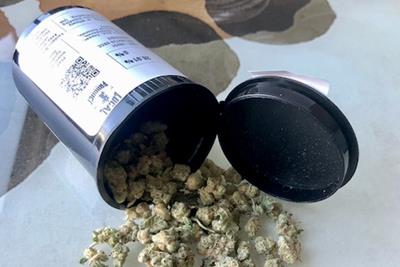
Wednesday August 11, 2021
By Erin Hiatt
 Education
Education
The cannabis industry has a packaging problem, and for the most part, it’s not the industry’s fault. Due to cannabis’ ongoing federal illegality and a high level of regulation (though some would say over-regulation) in legal states, cannabis packages require a lot of labeling which may contain testing information, cannabinoid composition, health warnings, identification numbers, and so on, which often creates the need that packages are much larger than they need to be.
Cannabis Packaging Regulations
In addition to the problem of having to create enough package space for clunky labeling, cannabis packages need to be difficult to get into — a problem for many medical cannabis patients. Though the rules vary from state-to-state, in California at least, cannabis packages must be:
- Child-resistant - plastic packaging must be 4 millimeters thick, heat sealed, and comply with the Poison Prevention Packaging Act
- Resealable: packages must include some type of closure, usually a lid or a seal
- Tamper-evident: have one or more indicators or barriers to entry, like a sticker across a lid
- Edibles must be in opaque packaging, ruling out glass
Colorado, the epicenter of legal weed, has similar extensive regulations. All of this creates a preference for plastics because they can be made to comply with both labeling and packaging requirements. This, plus a state’s need to monitor and regulate cannabis sales, has resulted in the creation of millions of tons of single-use plastics that for the most part end up as litter on the streets or in the landfill, where they can take up to, literally, 1,000 years to decompose. Yikes.
Advancements in Environmentally Friendly Packaging
However, some operators are working to make cannabis’ ecological footprint a little less monstrous. Take for example Colorado-based Sana Packaging, a company that develops cannabis packaging that uses plant-based hemp plastic, reclaimed ocean plastic, and other materials. Their goal is to bring about a “circular economy” for plastic by “designing out waste and pollution, keeping products and materials in use, and regenerating natural systems.”
At HISIERRA® in the Midwest, they’re tackling the problem of the exit bag by working with plant-based materials to manufacture bags that are both child-safe and cannabis compliant. For some extra eco-friendly cred, they are LEED (leadership in energy and environmental design) certified, and operate their factory with wind power.

In Santa Cruz, California, MM Green Packaging Solutions makes sustainable (or environmentally gentle) packaging for flower, pre-rolls, edibles, concentrates, and vape cartridges that are recyclable, biodegradable, or compostable.
Mary and Patrick Ersig of Ocean Cannabis Company are hoping to “smoke the ocean clean, one joint at a time.” In addition to being a cannabis brand in California, the Ersig’s — with their background in social work and community outreach and service — wanted to source their packaging from 100 percent reclaimed and recycled ocean plastic, with the goal of removing 10 tons of ocean plastic per year.
In an interview with Healthline, Mary Ersig pointed out the obstacle that even the best-intentioned cannabis companies face when deciding what kind of packaging to use.
“Each container from Oceanworks plastic costs 27 cents, while boilerplate plastic packaging from China costs pennies apiece,” she explained. For many firms operating on the margin, that difference could be a deal breaker.
Hemp plastic could be a perfect solution because it’s nontoxic, biodegradable, renewable, and stronger and more durable than petroleum-based plastic. Nonetheless obstacles remain; red tape in many states requires hemp biomass to be discarded separately from other materials or in the presence of a representative from a state’s department of agriculture, for example.
How You Can Help as a Consumer
So what’s a conscientious consumer to do? A great first move is to shop from companies that are doing the work of becoming more environmentally sustainable and reward them with your dollars and loyalty. Be sure to check out your local dispo for plastic substitutes like glass, hemp plastic, recycled plastic, or paper. If they don’t have them, ask. Make sure they know that sustainable packaging is important to you as a consumer.
Last but not least, check out your local government resources like this one from the city of Denver. It will give you an understanding of what can and cannot be recycled. In the meanwhile, shop thoughtfully. A thousand year-wait for a doob tube to decompose is much too long.
Does sustainable packaging impact your cannabis purchasing? Share your two cents in the comments.







